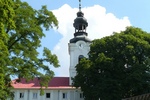Obory
| Fryderyk Chopin had an opportunity to visit the Carmelite monastery in Obory, to which the Dziewanowski family was strongly committed mainly though financial support of the monastery. In the monastery church there is well preserved organ, which young Fryderyk used to play according to local sources. Chopin’s visit to Obory is commemorated by a plate embedded in 1999 in the church wall with the following inscription: „In this church Fryderyk F. Chopin used to visit and play the organ in the summer of 1824”. | |  |
The Monastery of Calced Carmelites and the Church of Visitation of the Mother of God were founded by Łukasz and Anna Rudzowski in 1605. The buildings were made of wood and were totally destroyed by fire in 1612. The monastery was rebuilt in 1617 with the use of wood, which was gradually replaced by brick starting from 1627. The reconstruction works were completed as late as in the half of the 17th century. The church was erected in stages starting from 1642 (the nave) until 1747 (the tower). The church interiors were decorated in Baroque and Rococo style and the aisle dating back to 1696 features a Gothic Pieta from the 15th century. The Pieta was carved in lime wood and it was brought to Obory in 1605 in vague circumstances from the Carmelite monastery in Bydgoszcz. The Carmelites from the Bydgoszcz Monastery never accepted the loss of the graceful figure. They sought their rights in courts and in 1617 they even stole the figure. However, they returned it soon and now it stands in the church of Obory. The Pieta of Obory also referred to as the Painful Mother of God is a patron saint of the Dobrzyń Land. The figure survived the wars in the 17th and 18th century and during the Second World War it was hidden in a wooden box and buried in the ground outside the monastery. On 18.07.1976 Cardinal Stefan Wyszyński, the Primate of Poland, crowned the Pieta of Obory.
On the north side of the church there is a three-storied and three-winged monastery building with a small courtyard in the centre. South to the church there is a distinct hill – a former keep, on which a cemetery, considered as the oldest cemetery in the Dobrzyń Land, is located. The cemetery is a place of burial of numerous representatives of noble families from the vicinities as well as those connected with Chopin’s stay in the Dobrzyń Land. The stone stairs lead up to the Holy Cross Chapel erected in 1686 and rebuilt in the 19th century. Behind the chapel and on the top of the hill there is the oldest part of the cemetery, which used to be the former keep site. The church and monastery in Obory was decorated mainly in the Baroque and Rococo style in the 17th and 18th centuries. Numerous chapels and historical altars are undoubtedly the pride of the church. The Chapel of the Divine Providence with Jastrzębiec coat of arms of the Dziewanowski family was founded by Juliusz Dziewanowski for the Brotherhood of Divine Providence, to which the founder belonged. The altar table is decorated with open-work antependium with Jastrzębiec coat of arms and the Eye of Providence. Under the chapel there is a burial vault of the founders. On the route from Obory to Kikół it is worth visiting Chrostkowo to see the interesting wooden St. Barbara’s Church.
On the north side of the church there is a three-storied and three-winged monastery building with a small courtyard in the centre. South to the church there is a distinct hill – a former keep, on which a cemetery, considered as the oldest cemetery in the Dobrzyń Land, is located. The cemetery is a place of burial of numerous representatives of noble families from the vicinities as well as those connected with Chopin’s stay in the Dobrzyń Land. The stone stairs lead up to the Holy Cross Chapel erected in 1686 and rebuilt in the 19th century. Behind the chapel and on the top of the hill there is the oldest part of the cemetery, which used to be the former keep site. The church and monastery in Obory was decorated mainly in the Baroque and Rococo style in the 17th and 18th centuries. Numerous chapels and historical altars are undoubtedly the pride of the church. The Chapel of the Divine Providence with Jastrzębiec coat of arms of the Dziewanowski family was founded by Juliusz Dziewanowski for the Brotherhood of Divine Providence, to which the founder belonged. The altar table is decorated with open-work antependium with Jastrzębiec coat of arms and the Eye of Providence. Under the chapel there is a burial vault of the founders. On the route from Obory to Kikół it is worth visiting Chrostkowo to see the interesting wooden St. Barbara’s Church.
Developed by: Andrzej Hermann
See other localities on the Fryderyk Chopin Route in the Kujawsko-Pomorskie Province
Angielski
Tytuł:
Obory


